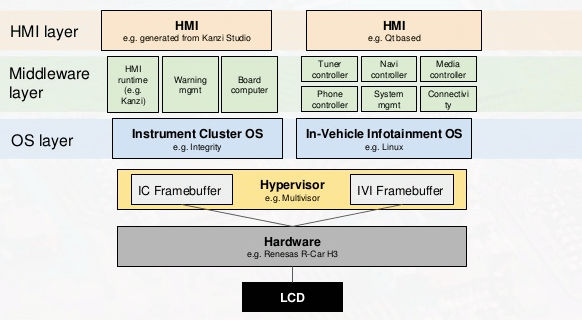Invalid input. Special characters are not supported.
Part four wraps this blog series up with a discussion around virualization and security for in-vehicle infotainment (IVI).
For the cockpit domain controller, virtualization is split between safety critical and noncritical functions, as depicted in the figure below. The safety critical applications are separately threaded to the hardware layer and are typically ISO26262 compliant to ASIL-B.
 Figure 1: Typical hypervisor-based IVI system software structure
Figure 1: Typical hypervisor-based IVI system software structure
The safety critical nature of the application, along with connectivity exposure in the platform, creates the need for security measures in the system design. These include:
- Secure boot
- Intrusion detection
- Secure over-the-air update strategies
- Enhanced Protection from cyber attacks
- Device tampering detection
- Embedded security management
It is well known that hypervisors create performance inefficiencies. Micron is working with key partners to implement direct memory virtualization where the hypervisor is replaced by a memory platform containing Single Root I/O Virtualization (SRIOV), which works directly in hardware, striving towards eliminating the need for a software-based hypervisor.
The Cockpit of the Future
With the continued migration of the automotive industry away from single vehicle ownership to fleet/shared ownership, ridesharing, and ultimately autonomous vehicles, the automotive interior will drastically change. Every seat in the vehicle interior has equal value moving forward. The consumers of the future will expect a seamless and consistent experience as they move from vehicle to vehicle within a fleet.
With respect to the architecture, it is clear the application of the domain space will be distributed amongst all the seating positions. There is no single architectural direction emerging at this point; however, several key points are becoming clear:
- The amount of required computing will very likely be distributed in the system.
- AI will play a very important role in a successful user experience, vastly increasing computing needs
- Power consumption of the domain system will become more critical
Micron’s advanced research in the areas of memory virtualization,, along with fundamental research in optimizing the power and calculation efficiency of AI, are playing an important role in charting the direction of the future automotive consumer experience.
After an amazing 88 years of evolution, the automotive industry continues to advance the user experience to new levels at a blinding pace. As data extensibility, security, and application developments in the areas of AI, IoT, and mobility move forward, Micron continues to play a key role in optimizing the enablement of consumer expectations as well as the cost-effective deployment of next-generation transportation worldwide. The automotive market represents the next major growth area for the memory business, and Micron is deeply involved in working closely with our automotive partners and customers to assure continued leadership in this market.
For more information on how Micron is enabling the automotive market, go to our Automotive Solutions page.
